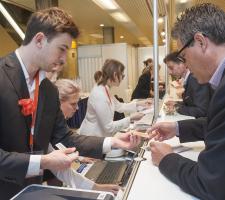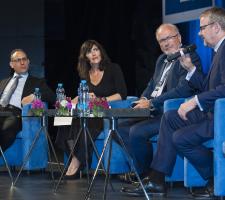
The bitumen industry needs to learn how to communicate with road owners, road users, and communities. This was one of the underlying themes to emerge from the Eurasphalt & Eurobitume 2016 Congress, held in the Czech capital Prague in June. Kristina Smith was there.
There was a different atmosphere to the sixth Eurasphalt and Eurobitume Congress, which ran in Prague between June1-3. For the first time in its 20-year history, the Congress was overseen by a professional moderator. With a background in television and public relations, moderator Katrina Sichel brought slickness – and a touch of glamour - to the proceedings, as well as an outsider’s perspective.
But her appointment, by organisers Eurobitume and the
“We have many technical experts in the industry who can tell us everything about asphalt but that does not necessarily make them the best communicators,” said Eurobitume president Siobhan McKelvey. “This year we really wanted to bring awareness to the messages that people could take away from the congress.”
One of the strongest messages to emerge from the congress was that the industry does need to do more to communicate with road users and road owners. There are some amazing research projects and technological developments underway, but without connections between research and practice, they cannot deliver on the benefits they promise.
The overall mood of the congress was upbeat. At the heart of this positivity is the increase in infrastructure spending in Europe and around the world and an expectation that spending on maintenance of road networks will start to rise.
Jean-François Corté, departing secretary-general of the World Road Association, who spoke on day one of the Congress, which this year was devoted to sessions looking at the bigger picture, said: “Transport is back on the agenda. Now transport and mobility are considered central to sustainable development.”
Sentiment among the 58 exhibiting companies was positive too. Compared to four years ago in Istanbul, there was a feeling of optimism, as firms looked to expand their presence across Europe.
Ota Vacin, road construction specialist with
“There are more opportunities in Western Europe now, as well as in Central and Eastern Europe,” said Vacin.
DuPont had held its own two-day paving conference in Prague prior to the Congress, in order to share customer experiences from different regions and to talk about some of the new grades of PMB DuPont is developing.
The
“All the markets are starting to recover after some years,” said Mario Jeutzsch, sales manager bitumen Western Europe for Nynas. “We see this already this year in Germany. From 2017, it will be Benelux and France, they all have positive signs it will recover.”
Leading a growing interest in biochemicals, US firm Kraton was publicising its recent acquisition of Arizona Chemical, which produces bitumen additives made from pine tree chemicals. Total was showcasing a new way for customers to order bitumen online, which is has been trialling in France and expects to roll out to other countries.
Chemical company Sasol used the Congress to launch a new was additive, Sasobit Redux, which it says can be used at temperatures up to 30° less than Sasobit. “There are also benefits in terms of ageing, which means you could increase the RAP content,” said Susann Gross-Matthal, sales and marketing manager asphalt additives Europe at Sasol.
Themes old and new
The need to communicate with a wider audience – and to encourage more people to attend the Congress – also promoted the organisers to run parallel, less technical, sessions. So alongside the traditional sessions on performance and testing of mixtures and of bitumen, delegates could choose health, safety and environment, smart management of road infrastructure, sustainable development, or a communications workshop.
The communications workshop, hosted by moderator Sichel, saw a panel provide insight into a range of campaigns across different media and a workshop session where groups of delegates talked through issues. “The communication workshop was one of the highlights for me,” said McKelvey.
The more usual themes of recycling and warm asphalt mixes both received their own session in the main conference hall. Lars Forstén, director of research for Lemminkäinen Infra of Finland, who gave the keynote address for the recycling session, was one of several presenters to remark on the lack of real case studies: “There were a lot of technical papers,” he said. “We are missing practical approaches and conclusions.”
Elsewhere at the Congress, however, there were a few practical examples in evidence. One of the most exciting papers on recycling was given in the Health, Safety and Environment session, by Marinus Huurman, research and development director for BAM Infra Asfalt.
Huurman presented a totally new way of recycling porous asphalt, LE2AP (Low Emission Asphalt Pavement), a method that sees used asphalt broken down into its constituent materials. The goal of the project, sponsored by the European Commission’s LIFE programme, is to use over 80% recycled material, mixed at 80 degrees C and providing a 7dB noise reduction. (See World Highways May 2016 for more detail on LE2AP).
The session on warm mix asphalt (WMA) emphasised the pivitol role that road owners must take in advancing ‘new’ technology. Elvin Olav Andersen, technical director at
Andersen showed that the use of WMA in Europe was close to zero for many years, until French organisation USRIP recommended its use. Initiatives in Denmark, Switzerland, Sweden, Turkey and the Czech Republic followed; currently 6 percent of asphalt laid is warm mix.
Procuring innovation
One of the calls from Egbert Beuving, secretary general of EAPA during the concluding session of the congress, was for clients to look to different forms of procurement which would encourage innovation, by sharing risk rather than pushing it all onto the contractors: “We all need contracts that allow us to innovate and to use new technology,” he said.
Himanshu Argarwal of
There were a few examples of how procurement forms are encouraging innovation. Arian de Bondt, director at Ooms Civiel of the Netherlands revealed how his firm had spent four years and Euro2m to develop a third-generation porous asphalt with high noise-reducing capabilities.
The motivator for this investment in R&D by Ooms Civiel was the form of contract: a 20-year public private partnership (PPP) deal for the A15 in Rotterdam. “We wanted a longer life for the pavement, 12 years compared to eight or 10 years because with a maintenance period of 20 years we would need to remove it only once,” de Bondt explained.
During the Road Owners and Road Users session, Donna James, pavement team leader at
In a session on Smart Management of Road Infrastructure, Christophe Nicodeme, director general of the European Road Federation, mentioned a progressive approach to asset management. The road authority in Belgium’s Walloon region employed PwC to establish the state of the road network and list priorities based on benefits delivered, such as accessibility and employability. Armed with these calculations of economic benefits, the authority doubled the budget for 2016 to 2019 to €640m.
These examples all involve major road authorities and roads, but as several presenters mentioned during the congress, it is local authorities that are responsible for much of Europe’s road network. How to communicate with these decision-makers, many of whom we would never meet at such a congress, remains a huge question.
Social media could provide part of the answer. Moderator Sichel urged delegates to take to Twitter several times during the Congress, which some of them did. It’s a small start, but perhaps another message which McKelvey hopes people will take back to their own companies and expand on.
“I believe everybody has a role to play in communicating,” she said.
Bigger is better for Shell
It’s a time when many players are leaving the bitumen market. But as uneconomic refineries close and others upgrade to produce higher-value products from their residues,
“We have taken a conscious decision to continue with bitumen production, focussing on nine refineries around the world – ‘mega refineries’ in terms of bitumen - which produce at least 1m tonnes of bitumen a year,” said John Read, Shell’s general manager specialities technology.
“Scale matters,” said Thomas Moons, general manager, specialities, Europe & South Africa, Shell. “When you buy bitumen from Shell, you know we have nine refineries that can serve you. If ever something unexpected happens in one refinery, we can bring bitumen from another.”
Shell’s nine bitumen manufacturing facilities on five continents are complemented by a network of 25 terminals around the world. Though not all the bitumen sold by Shell is made by Shell. “We do buy from third parties and it goes through a stringent vetting process,” said Read. “My team spends an inordinate amount of time making sure it is fit for purpose and meets Shell’s HSE standards.”
As refineries get bigger, so do the customers, according to Dave Foster, business manager, bitumen UK & Ireland at Shell: “Fundamentally we have the same customer base, but it has been rationalising,” he said, referencing the recent purchase of
Size also means fire power when it comes to R&D. Read and his team have been working on some inventive uses for roads, including electricity and light production and absorption of pollution. However, selling these crossover technologies to governments that are divided into strongly demarcated responsibilities remains a challenge.
The future for bitumen, according to Read, will see a focus on the chemistry of bitumen and using new chemistries, such as bio-additives. “The next round of innovations will be around how you both extend bitumen using these products and how you use different chemistries to to generate new outcomes. There will be some very interesting surprises...”
Gazprom grows Russia’s PMB market
In just a few years, Russian oil company
PMB now accounts for around 3% of Russia’s bitumen use, with Gazprom producing PMB at its Moscow, Omsk, Vyazma and Ryazan plants.
Gazprom started production of PMB at Ryazan in 2011, but more recently teamed up with
“Three years ago, we looked around the world to see what experience there was,” said Irina Ushakova, corporate communications at Gazprom. “That’s how we started the relationship with Total: our choice was to use the Styrelf technology.”
With the renovation of its Ryazan plant, Gazprom reports that PMB production capacity had risen from 32,000 tonnes annually to 43,000 tonnes by 2015. In addition to traditional export countries of Mongolia and Kazakhstan, Gazprom has started exporting to the Czech Republic, Romania, Italy, Poland, Bulgaria, Latvia, Turkey and Israel and it’s made trial shipments to Latin America and Africa.
This year will see the opening of a research and development centre at Ryazan. “We want to develop our range of products and carry out investigations on behalf of our clients,” said Ushakova.















